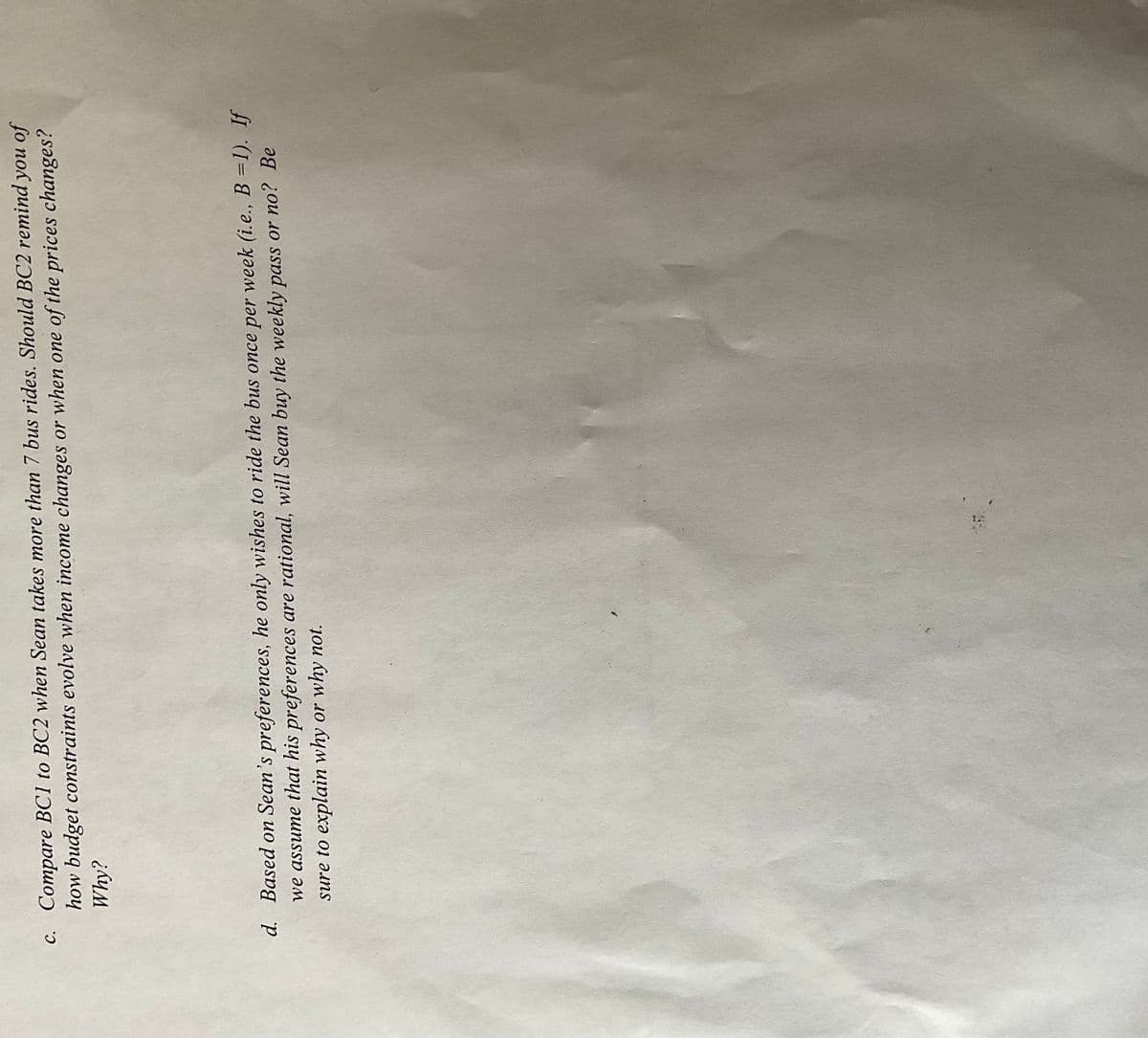Sean budgets $30 per week for transportation. To get around, he can either drive his car (D) take the city bus (B). The cost/trip for driving is $5 (PD) while the cost/trip for the bus is $2 (PB). Sean's Transportation Budget a. Driving 15 10 5 5 10 15 Bus Write down Sean's budget constraint given the information above. Graph the budget constraint as well using the graph above. Be sure to label it as BCI on the graph. b. Instead of paying per ride, Sean can also buy a weekly pass. The weekly pass costs a flat fee of $10 and is good for 7 rides. If Sean chooses to use the bus for any rides beyond those seven, he faces the normal price of $2/ride. Write down Sean's Budget constraint and graph it using the same figure above. Label as BC2. [Hint: Remember, Sean only pays the flat fee if he takes any trips, it does not apply if he only uses his car!]
Sean budgets $30 per week for transportation. To get around, he can either drive his car (D) take the city bus (B). The cost/trip for driving is $5 (PD) while the cost/trip for the bus is $2 (PB). Sean's Transportation Budget a. Driving 15 10 5 5 10 15 Bus Write down Sean's budget constraint given the information above. Graph the budget constraint as well using the graph above. Be sure to label it as BCI on the graph. b. Instead of paying per ride, Sean can also buy a weekly pass. The weekly pass costs a flat fee of $10 and is good for 7 rides. If Sean chooses to use the bus for any rides beyond those seven, he faces the normal price of $2/ride. Write down Sean's Budget constraint and graph it using the same figure above. Label as BC2. [Hint: Remember, Sean only pays the flat fee if he takes any trips, it does not apply if he only uses his car!]
Principles of Economics (MindTap Course List)
8th Edition
ISBN:9781305585126
Author:N. Gregory Mankiw
Publisher:N. Gregory Mankiw
Chapter21: The Theory Of Consumer Choice
Section: Chapter Questions
Problem 1PA
Related questions
Question
![Sean budgets $30 per week for transportation. To get around, he can either drive his car (D) or
take the city bus (B). The cost/trip for driving is $5 (PD) while the cost/trip for the bus is $2 (PB).
Sean's Transportation Budget
a.
Driving
15
10
5
5
10
15
Bus
Write down Sean's budget constraint given the information above. Graph the budget
constraint as well using the graph above. Be sure to label it as BCI on the graph.
b. Instead of paying per ride, Sean can also buy a weekly pass. The weekly pass costs a flat
fee of $10 and is good for 7 rides. If Sean chooses to use the bus for any rides beyond
those seven, he faces the normal price of $2/ride. Write down Sean's Budget constraint
and graph it using the same figure above. Label as BC2. [Hint: Remember, Sean only
pays the flat fee if he takes any trips, it does not apply if he only uses his car!]](/v2/_next/image?url=https%3A%2F%2Fcontent.bartleby.com%2Fqna-images%2Fquestion%2F314f0635-1dd9-4d26-9205-7f03c7b2e19c%2F2c9337c8-5e35-452a-ab23-329fcdd8ba87%2Fwy9yoyp_processed.jpeg&w=3840&q=75)
Transcribed Image Text:Sean budgets $30 per week for transportation. To get around, he can either drive his car (D) or
take the city bus (B). The cost/trip for driving is $5 (PD) while the cost/trip for the bus is $2 (PB).
Sean's Transportation Budget
a.
Driving
15
10
5
5
10
15
Bus
Write down Sean's budget constraint given the information above. Graph the budget
constraint as well using the graph above. Be sure to label it as BCI on the graph.
b. Instead of paying per ride, Sean can also buy a weekly pass. The weekly pass costs a flat
fee of $10 and is good for 7 rides. If Sean chooses to use the bus for any rides beyond
those seven, he faces the normal price of $2/ride. Write down Sean's Budget constraint
and graph it using the same figure above. Label as BC2. [Hint: Remember, Sean only
pays the flat fee if he takes any trips, it does not apply if he only uses his car!]

Transcribed Image Text:c. Compare BC1 to BC2 when Sean takes more than 7 bus rides. Should BC2 remind you of
how budget constraints evolve when income changes or when one of the prices changes?
Why?
d. Based on Sean's preferences, he only wishes to ride the bus once per week (i.e., B =1). If
we assume that his preferences are rational, will Sean buy the weekly pass or no? Be
sure to explain why or why not.
Expert Solution
This question has been solved!
Explore an expertly crafted, step-by-step solution for a thorough understanding of key concepts.
Step by step
Solved in 2 steps with 3 images

Knowledge Booster
Learn more about
Need a deep-dive on the concept behind this application? Look no further. Learn more about this topic, economics and related others by exploring similar questions and additional content below.Recommended textbooks for you

Principles of Economics (MindTap Course List)
Economics
ISBN:
9781305585126
Author:
N. Gregory Mankiw
Publisher:
Cengage Learning

Principles of Economics (MindTap Course List)
Economics
ISBN:
9781305585126
Author:
N. Gregory Mankiw
Publisher:
Cengage Learning